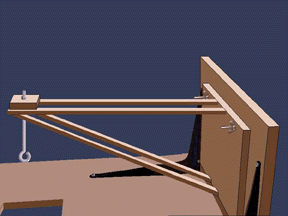Go Back to The Summer Institute Home Site
At Durham Academy, the first years have a seminar class. In each seminar class, we study a certain topic for 2 weeks. The choices were: Engineering, Water Quality, Weather, Biodiversity, Sedimentation, and Marine Mammals. I chose Engineering and what we had to do was build a boomilever that holds a certain amount of sand. Another goal was to have the lightest boomilever out of all of them. Any boomilever that broke before reaching 15 kg was not qualified.
 The third day after being at Durham Academy, we started to build our boomilevers. The materials that we used were balsa wood, glue, and razor blades. We used balsa wood because it is light but very sturdy. We all worked for about 2 weeks on our first boomilever since we only had one period to work them. Once the field studies week came, we had all day to do them and some of the people in the group completed more than one. We used all types of glue because some glues dried faster than others, so we experimented with what worked and what didn't.
The third day after being at Durham Academy, we started to build our boomilevers. The materials that we used were balsa wood, glue, and razor blades. We used balsa wood because it is light but very sturdy. We all worked for about 2 weeks on our first boomilever since we only had one period to work them. Once the field studies week came, we had all day to do them and some of the people in the group completed more than one. We used all types of glue because some glues dried faster than others, so we experimented with what worked and what didn't.
During the week of field studies, we began to test our boomilevers. As you can see in the pictures above, the boomilever is attached to a base by a screw, washer, and wing nut. The loading block is made up of a block of wood and a screw with a loop at the end.  A chain is put around the handle of the bucket and the top links of the chain are put on a S-hook. the other side of the S-hook is put into the loop on the screw. If your boomilever holds that much then you have completed the first step. The person who made the boomilever loads the sand into the bucket. Once the boomilever breaks, the complete load is weighed. There is an equation that is used to find the complete efficiency of the boomilever.
We when tested our boomilevers, many of us had different results. We all used a laminated base that added about 50 grams to our wieght which would make our effieciency lower. Some boomilevers broke early and some broke after holding about 10 pounds. The highest effieciency for a boomilever in our class was 547. We built more boomilevers, and when we tested them again, many of us improved on our work.
A chain is put around the handle of the bucket and the top links of the chain are put on a S-hook. the other side of the S-hook is put into the loop on the screw. If your boomilever holds that much then you have completed the first step. The person who made the boomilever loads the sand into the bucket. Once the boomilever breaks, the complete load is weighed. There is an equation that is used to find the complete efficiency of the boomilever.
We when tested our boomilevers, many of us had different results. We all used a laminated base that added about 50 grams to our wieght which would make our effieciency lower. Some boomilevers broke early and some broke after holding about 10 pounds. The highest effieciency for a boomilever in our class was 547. We built more boomilevers, and when we tested them again, many of us improved on our work.
Made: 2001